Saint Estèphe 2018
Posted on January 24, 2021
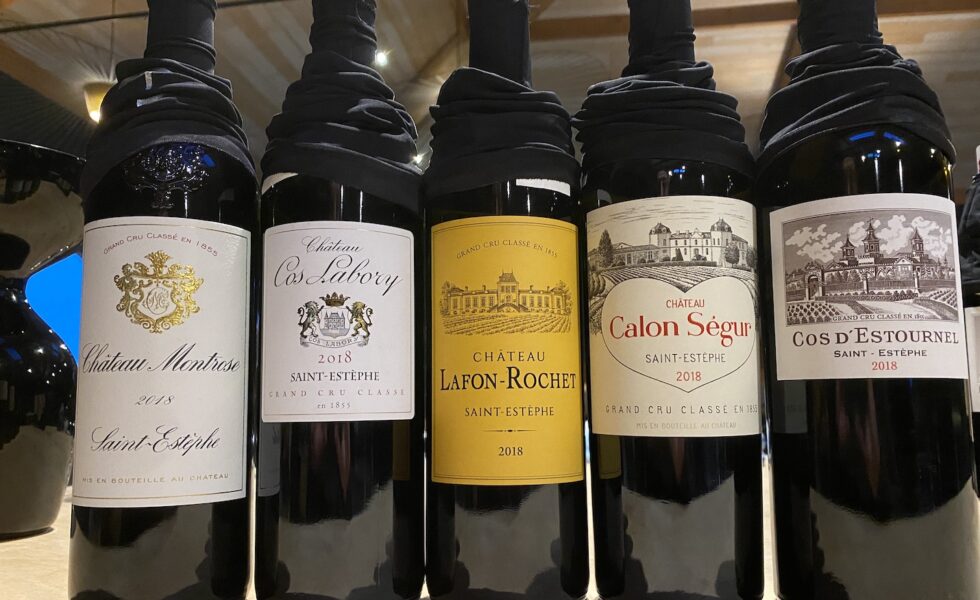
By Panos Kakaviatos for wine-chronicles.com
24 January 2021
Fascinating to see – in a blind tasting of the five classified growths – just how impressive Château Montrose turned out to be. I have tasted the wine twice from bottle, once at the estate, once in the blind tasting (held at Château Lafon-Rochet), and although I still think that the 2016 will be better (or the 2019 for that matter, which I had tasted side-by-side), the 2018 Montrose impresses me most among the Saint Estèphes in 2018.
As usual, wines in bold I liked in particular. When red and bold, even more. And when underlined, wine nirvana 😊🍷😍.
Several wines tasted blind, others non blind.
Château Beau Site – Clearly nice this blend of 73% Cabernet Sauvignon, 25% Merlot and 2% Petit Verdot: At once very tasty and agreeable with density and power. Here an example of affordable fine 2018 Bordeaux – at about €20 a bottle in Europe. Tasted at Château Batailley with owner Philippe Casteja, who decided to leave the formal cru bourgeois system, but never mind this wine is still identified as such, and it is a very good wine indeed in 2018. 92
Château Calon Ségur – Tasted blind, this came across about as I had rather expected from barrel, with impressive “amplitude” and mid-palate density. The expressions of ripe dark fruit, spice and mint from the Cabernet Franc are pleasing. But there is a sense that the 100% new oak aging, combined with nearly 15% alcohol, leads to a drying finish in this blend of 65% Cabernet, 17% Merlot, 15% Cabernet Franc and 3% Petit Verdot. Such a high level of alcohol drew much oak derived tannin, and from a classified growth of this calibre, I am left perplexed. Maybe over time, the breed of the terroir will shine through. 2018 was the first vintage ever that the estate arrived at the same level of high alcohol for both Cabernet Sauvignon and Merlot and that is quite astounding. Now the pH at 3.75 is not the highest encountered in this vintage, and just enough acidity balances things, but I would rather go for the 2016 to be sure. Conservative score from yours truly. 93 Read More
Pauillac 2018
Posted on January 24, 2021
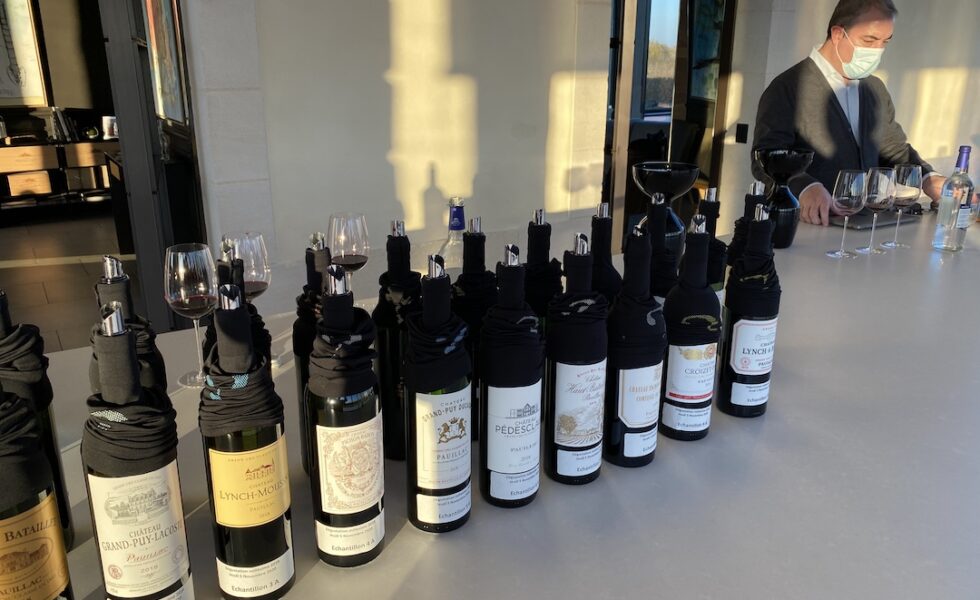
Power and refinement
By Panos Kakaviatos for wine-chronicles.com
24 January 2021
Pauillac boasts some excellent wines in this vintage, some in my Top Ten. As said in the intro text, in many cases 2016 (and even 2019) may outshine 2018 in the longer run. However, some estates were capable to tirer son épingle du jeu, as the French say, and “rise to the occasion” to rival not only 2019, but also 2016. As with Saint Julien, I tasted fine Pauillacs blind at Château Pedesclaux with Jane Anson and Yohan Castaing. I also tasted – non blind – Château Lafite-Rothschild, Château Duhart Milon, Château Mouton Rothschild, Château Pontet Canet, Châteaux Batailley and Lynch Moussas at the respective estates (the latter two also in the blind tasting). In addition, Châteaux Clerc Milon and d’Armailhac at the offices of the Bordeaux Wine Council, during which we spoke with Jean Emmanual Danjoy, who is taking over direction of the estates of Baron Philippe de Rothschild from Philippe Dhalluin.
First Wines of Pauillac 2018 in bottle (some tasted blind, others at the estates)
Château d’Armailhac – Clocking in at 14.5% alcohol, this blend of 55% Cabernet Sauvignon, 30% Merlot, 10% Cabernet Franc and 5% Petit Verdot is both ripe and tannic. Pretty much as from barrel, the aromas are clean and pure, the palate smooth and even lacy, with underlying Pauillac grip. As the quality of the harvest improves at this estate, the percentage of new oak is increasing. Not too long ago, it was only about one-third, but for 2018, the wine aged in 50% new oak. Sure, there is some imposing tannin on the finish, but in a good way, meaning that you can cellar this with confidence. Excellent wine! Tasted at the CIVB offices of Bordeaux. 94 Read More
Margaux 2018
Posted on January 24, 2021
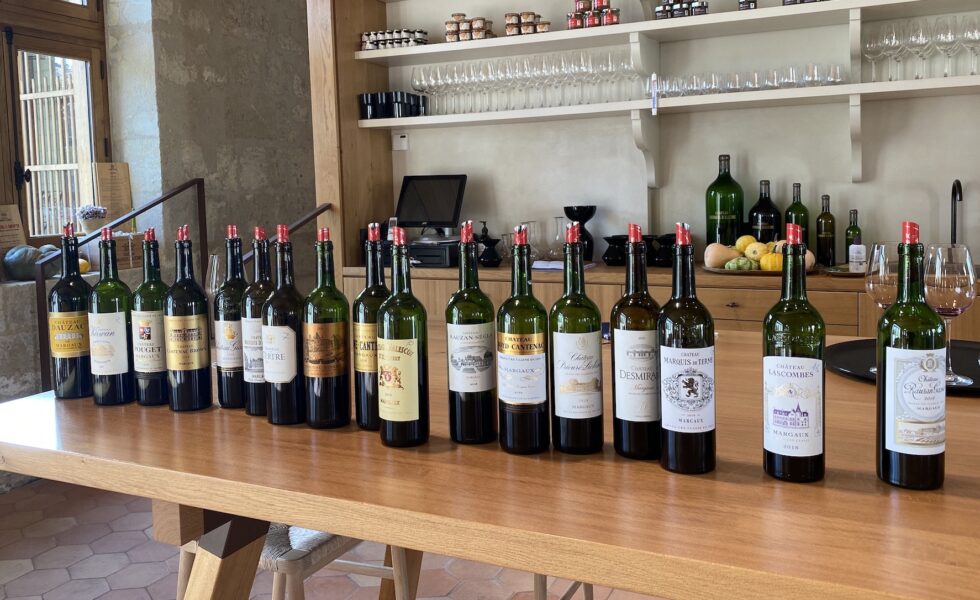
Stars among the more challenged
By Panos Kakaviatos for wine-chronicles.com
24 January 2021
Some estates shined bright, but the nature of the vintage challenged Margaux more than it did Saint Julien and Pauillac, or for that matter, the cooler limestone and clay soils of the Right Bank. Yet I do wonder whether we critics may be rushing to score after an immediate opening of the bottles, spending but an hour with some of these wines that come across tannic and powerful, requiring aging to be sure. Nevertheless, in some cases fruit ripeness comes with harder tannins. Sometimes the wines come across more like powerful Pauillacs than Margaux, so it will be a question of assessing again in 10 years to see where they will be. The very best wines display Margaux refinement and grace as well as power and density. Unless otherwise noted – for example some Cru Bourgeois and Châteaux Palmer and Margaux – the wines listed below were tasted blind at Château Marquis d’Alesme Becker on 5 November, with Jane Anson and Yohan Castaing.
Tasting notes in alphabetical order, and as usual: when in bold, I liked in particular. If red and bold, even more. And if underlined, too, a kind of wine nirvana.
Château d’Arsac – Not tasted blind. This wine, delivered to Strasbourg as part of the Cru Bourgeois Exceptionnel wines, with thanks to the Alliance de Cru Bourgeois, rather exemplifies my intro text. It certainly needs time to settle down, and I had the luxury to be able to revisit. The nose displays crushed mint and pencil lead, reflecting the 72% Cabernet Sauvignon in the blend that includes 28% Merlot. There is tannic edge to the wine that clocks in at 13.5% alcohol that on day one seemed charmlessly hard but less so over a two-day period. I do appreciate the impressive density and power, but the wine does not reflect the elegance one expects from the appellation, so I will be rather conservative in my positive score. 91
Château Boyd Cantenac – Aged in 80% new oak, this blend of 65% Cabernet Sauvignon, 19% Merlot, 10% Petit Verdot and the rest Cabernet Franc exudes evident toasty notes on the nose along with ripe dark fruit and spicy notes. There is a certain freshness here, clocking in at 13.5% alcohol, and impressive density and tannic edge for aging, although it lacks, again, enough Margaux charm for a higher score. Revisit in 10 years! 93 Read More
Saint Julien 2018
Posted on January 24, 2021
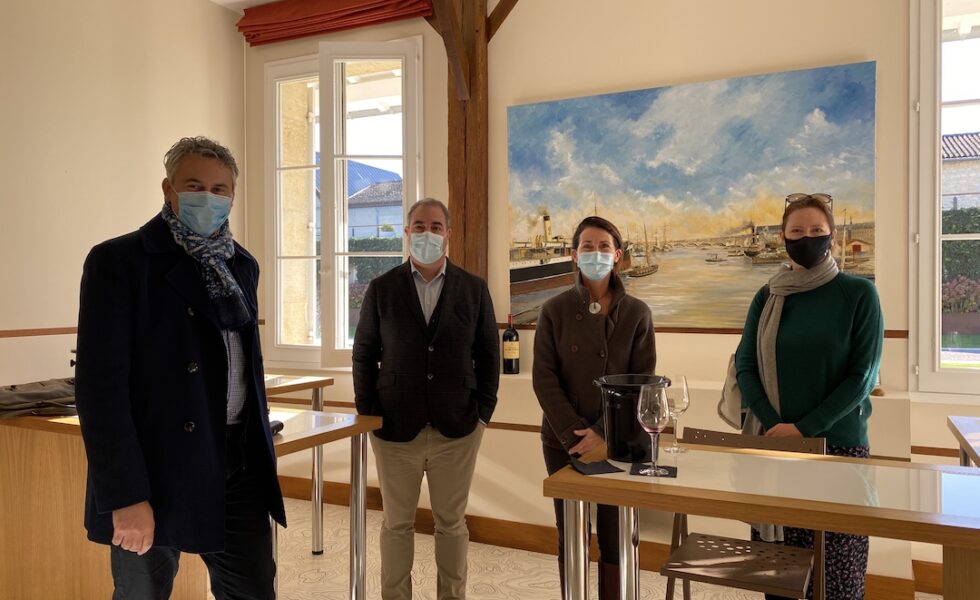
Consistent excellence
By Panos Kakaviatos for wine-chronicles.com
24 January 2021
Consistently excellent in 2018, recently bottled wines from this appellation fulfill their promise from barrel: elegant, suave, sometimes powerful, with grip, but overall refined and fresh. I give an edge to the 2016 vintage for superior freshness, as Didier Cuvelier of Château Léoville Poyferré agrees. Still, 2018 could win on palate density in some cases. Another reflection of success were the consistently good second wines of the classified growths, when tasted blind with Jane Anson and Yohan Castaing. For sheer affordability, special mentions to Pavillion de Léoville Poyferré and Connetable de Talbot, each about $30/€30 retail. The First Wines were tasted blind at Château Léoville Poyferré. But Château Léoville Las Cases was tasted at the estate, not blind, just next door. Tasted outside this series, Las Cases (and Clos du Marquis) come at the end.
As usual, when in bold, I liked especially. If red and bold, even more. If underlined, too? A kind of wine nirvana.
First Wines 2018 in bottle
Château Beychevelle – Deep and dark fruit aromas. The palate has opulence, but today just a bit tightly wound up, but in a good way! There is notable power on this wine, which impresses me. Maybe a hint of heat that recalls the expression “fire in the belly”. Not quite the same high level of finesse one gets from 2016, mind you. But going back to it, you do get elegance and refinement … tout de même! A wonderful Beychevelle in the making! 95+
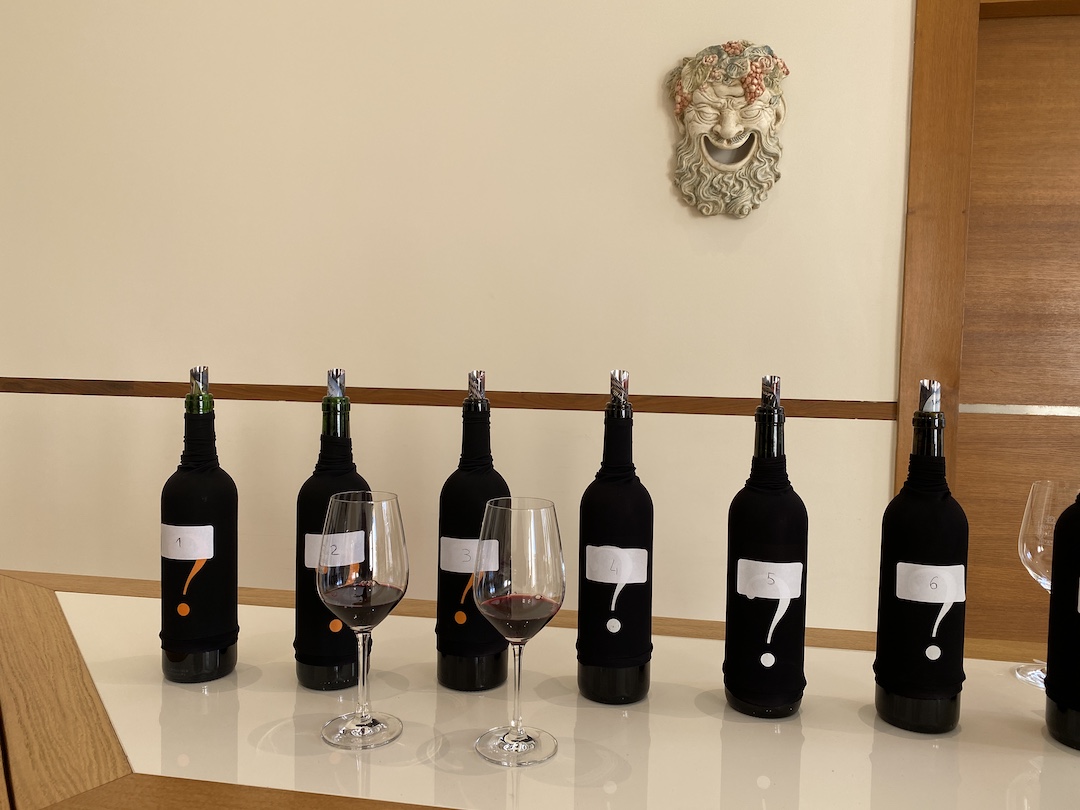
The joke is on you, when tasting blind.
Château Saint Pierre – Subtle aromatic expression here but within 10 minutes of aeration it yields juicy blackberry, plum and blackcurrant. Tobacco, too. The palate has depth, but even tighter than in the preceding wine. That said, the fire in the belly aspect not as strong, although you get a sense of high 2018 octane. There is a sense on the palate of tasting the skins from a ripe grape, with power behind them, and tannins that are very ripe and present. In the end, this just needs time in a carafe. Great potential. Long finish. 94 Read More
Pessac-Léognan 2018 reds
Posted on January 24, 2021

Hits amidst gravel and heat
By Panos Kakaviatos for wine-chronicles.com
24 January 2021
2018 was not the ideal vintage for warmer soils, so I would tip my hat more to 2016 as the recent vintage to purchase from Pessac-Léognan. Still, some very good to excellent wines. A few stars and several superb price/quality ratio wines make 2018 most interesting. Many tasted non blind with Jane Anson in Bordeaux. The bottle of Château Pape Clement was corked, so the estate delivered one to me in Strasbourg. The wines of Domaine Clarence Dillon tasted at the CIVB offices of Bordeaux. Fun fact: Many wines had 14.5% on the label, so as to avoid having to add the Trump tax of 25% to still wines. No doubt many of these were above 14% but not close to 14.5.
As usual, if in bold, I liked in particular. If red and bold, even more. When underlined, too, a wine nirvana.
Château Bouscaut – Bravo to Château Bouscaut, which not too long ago, showed a tendency towards ultra ripeness. One would think that in a solar vintage like 2018, with record alcohol levels – 14.5% on the label – that we would get big wine. But no, this blend of 58% Merlot, 36% Cabernet Sauvignon and 6% Malbec, cropped at a healthy 42 hectoliters per hectare, benefitted from clay on limestone terroir that buffered the intense dry heat stress of 2018. I liked it from barrel and that promise is fulfilled from bottle, with a sap-filled mid palate, poise and juicy refinement. Smooth, succulent and savory, the wine displays bright ripe fruit, albeit a touch of headiness, but really that is quibbling. Lovely wine to some extent “reigned in” with the dark spice and serious feel coming from the Malbec. Solidly fair pricing at about €36 retail including taxes. 94
Château Carbonnieux – The nose comes across more crackling red cranberry, as compared to the Bouscaut tasted just before, just as I had experienced from barrel. I like the dominant leafy Cabernet in the blend – about 65% – lending grip, but the tannins lack some refinement, leading to a somewhat pinched finish. Cheers to the iodine aspect that could be due to earlier picking, but this wine illustrates the limits of the 2018 vintage. Aged in 40% new oak. Label indicated alcohol: 14.5% 91+
Château Les Carmes Haut Brion* – A top wine from the rather hot and gravely soils of the famous Pessac-Léognan appellation, as director Guillaume Pouthier pulled out all stops to maintain freshness, fermenting grapes at over 50% whole cluster and not de-leafing, so as to ensure that his grapes were not grilled by the sun. Blending 37% Cabernet Franc, 34% Cabernet Sauvignon and the rest Merlot, the wine is both delectable and serious, conveying wet stone like “minerality” while being driven by juicy, ripe fruit flavors. The alcohol is somewhat low for the vintage, at 13.75, with excellent acidity to balance that. While on the higher end of the price spectrum for this category, this wine from barrel is more engaging to me than first growth Château Haut Brion, tasted the same day. What I wrote from barrel applies from bottle, after tasting both wines about the same time in Bordeaux, non-blind. Bottled in September last year, it has aged 21 months in 79% new oak and the rest divided between 10% big Alsatian oak and 10% amphorae. “If we want to make wines that are rich and powerful, we can” said Pouthier, but that is not the goal here. The rather high 85 IPT tannic index in 2018 was extracted softly. In fermention vats, the cap was held down with entire grapes underneath so the extraction came more from the skins and “it is more gentle”, he says. It is the crasse de fer that you get from the terroir to get wet stone minerality on the palate. The pH is 3.6 (in 2009 and 2010, it was 3.9). “We worked the soils to reduce the potassium and that has helped reduce the pH”, he explains. A wine with real power remaining subtle, with tobacco aspects from the Cabernet Franc, also like silex. The peony aromatics kick in on the long with perfumed elegance. A great wine, and I bought six bottles. 97 Read More
 Wine Chronicles
Wine Chronicles
Recent Comments